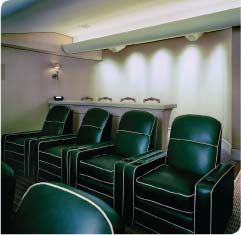The Networked Home
The Era of the "Smart House" is Here

Ah, that’s just the beginning. That’s just the boring stuff.
The fun stuff—the sound system, the TVs, the Internet,
can also be controlled on the same interface. And when we
say sound system, we’re not talking about a CD player with
disk-changer. We’re talking about a state-of-the-art, multizone,
server-driven, high-definition, digital music library,
automatically downloaded from your CDs as they play; or
streaming live from satellite radio or your cable provider.
And TVs? We’re talking big, BIG, screens.
Want to keep up with the Jetsons? It’s more affordable
than you might think.
Rick Milam is owner of Audioport Ltd. which sells and
installs custom home entertainment systems from its
stores in Kansas City and Overland Park. With more than
20 years in the business, Milam has seen the technology
in his segment of the industry evolve from turntables,
cassette decks, and a nice pair of speakers, to integrated,
wireless, whole-house home entertainment networks.

“The quality available these days is really beyond what
we could ever have imagined just a few years ago,” he
says. “Stereo systems can achieve audio quality that’s
truly as good as live. Probably better. And the quality of
television audio and image, especially on the big screens
installed in an environment created especially for viewing,
is really quite phenomenal.”
Milam’s Audioport colleague, Steve Stucky, specializes
in whole-house electronics. He says an entry-level custom
home entertainment system can be installed for about
$5,000. “And to be honest, there is no top-range on what
you can spend. You’re limited only by your imagination
$50–75,000 range. Very few exceed $100,000.”
It’s easy to see how costs could add up pretty quickly.
Milam says that though good stereo speakers start at
about $300 a pair, his store sells speakers that go for
$30,000 per pair.
Stucky says that the best time to buy a high-end, integrated,
whole-house electronic system is when you’re
building your house. “Before the sheet rock goes up; that’s
when installation is least expensive and the options and
flexibility are optimal. That’s when it’s easiest to integrate
home security networks, irrigation systems, HVAC, etc.But, realistically, most homeowners install
their systems after their homes
are built.”
Stucky adds that some homeowners
buy home generators to keep all their
systems running in the event of a power
loss.

Stucky and Milam say that people are surprised at all the things that can be done with a media-server based home entertainment system. “You can manage your home videos, digital family photos, your DVD collection, in addition to all your music,” Stucky point out.
Milam says that integrated wholehouse
entertainment systems are not
just about convenience. “It’s really
about quality. People are so used to listening
to music on their iPods or their
car radios that they really no longer
have any idea what it sounds like on a
high-quality system. iPods are great for
mobility and convenience, but you’re
not hearing most of the music.
Literally. The digital files are so
compressed that much of the digital
information—which is the music—
isn’t there. And if you’re using an iPod
docking station as the hub of your
home audio system, well, you’re
cheating yourself. The only control you
have over the sound is the volume.
Admittedly, the ability to control all
your household electronics from a
single touch-screen interface is convenient,
and frankly, pretty cool, but
it’s the quality of your entertainment
experience that really makes
the difference. It’s a world of difference.”![]()